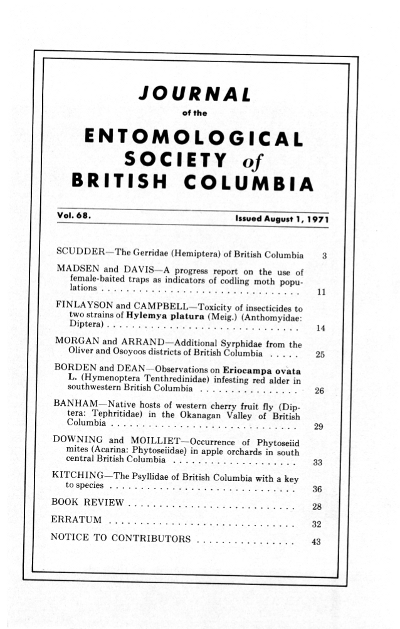Observations on <i>Eriocampa ovata</i> L. (Hymenoptera: Tenthredinidae) infesting red alder in southwestern British Columbia
Keywords:
<i>Eriocampa ovata</i>, Hymenoptera, Tenthredinidae, red alderAbstract
As in Quebec, <i>Eriocampa ovata</i> L. in British Columbia is bivoltine, parthenogenetic and overwinters as a prepupa. Unlike <i>E. ovata</i> in Quebec, the first instar larvae emerge on the lower side of the leaf, and pass through 6 or 7 rather than 5 or 6 larval instars. Defoliation characteristically leaves only the midrib and main secondary veins. In limited areas, small trees may be completely defoliated.References
Bouchard, P. 1960. La tenthrede a thorax rouge de I'aulne, Eriocampa ovata (L) (Hymenoptera: Tenthredinidae). Ann. Soc. Ent. Que. 6:69-80.
Bridgeman, J.B. 1878. On parthenogenesis in the Tenthredinidae. The Ent. 11:191-192.
Raizenne, H. 1957. Forest sawflies of southern Ontario and their parasites. Can. Dept. Agric. Publ. No. 1009.
Ross, H.H. 1951. p.61. In: C.F.W. Musebeck and K.V. Krombein, Hymenoptera of America north of Mexico, U.S. Dept. Agric., Agric. Mon. No.2.
Downloads
Published
Issue
Section
License
Authors who publish with the Journal of the Entomological Society of British Columbia agree to the following terms:
-Authors retain copyright and grant the journal right of first publication with the work simultaneously licensed under a Creative Commons Attribution License that allows others to share the work with an acknowledgement of the work's authorship and initial publication in this journal.
-Authors are able to enter into separate, additional contractual arrangements for the non-exclusive distribution of the journal's published version of the work (e.g., post it to an institutional repository or publish it in a book), with an acknowledgement of its initial publication in this journal.
-Authors are permitted and encouraged to post their work online (e.g., in institutional repositories or on their website) prior to and during the submission process, as it can lead to productive exchanges, as well as earlier and greater citation of published work (See The Effect of Open Access).


